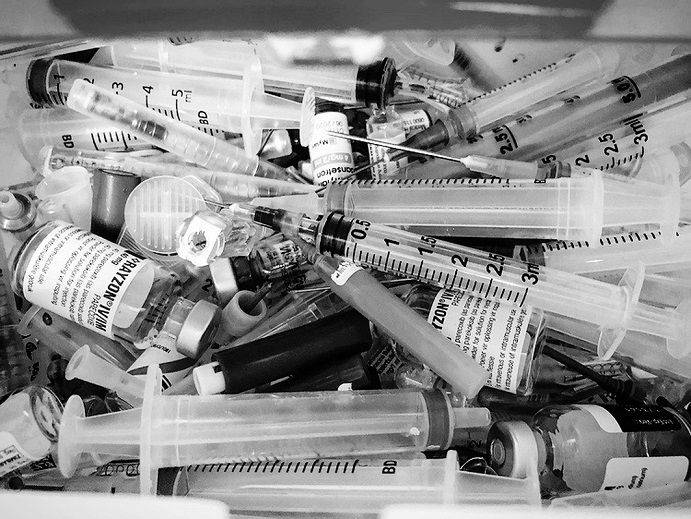The Ministry of Environment and Forests under the Government of India had notified the Bio-Medical Waste (Management and Handling) Rules, 1998 under the Environment Protection Act 1986 (29 of 1986) and further notified the Bio-Medical Waste Management Rules in 2016 as measures to manage the disposal of biomedical waste in the country.
The above guidelines direct hospitals to enable proper biomedical waste management in their premises from collection and segregation to treatment and disposal. In a country like India, there is a huge amount of biomedical waste generated each year due to the medical requirements of its huge population.
According to the National Center for Biotechnology Information (NCBI) website biomedical waste is defined as ‘Biomedical waste is defined as any waste, which is generated during the diagnosis, treatment or immunization of human beings or animals, or in research activities pertaining thereto, or in the production or testing of biologicals.’
Biomedical waste can be broadly classified into ten categories, according to NCBI:
- Animal waste – (including animals used in research and waste originating from veterinary hospitals and animal houses)
- Human anatomical waste – (tissues, organs, body parts)
- Microbiological and biotechnology waste – (including waste from lab cultures, stocks or specimens of microorganisms, live or attenuated vaccines, wastes from production of biologicals)
- Waste sharps – (used/unused needles, syringes, lancets, scalpels, blades, glass)
- Discarded medicines and cytotoxic drugs
- Soiled wastes – (items contaminated with blood and body fluids, including cotton dressings, linen, plaster casts, bedding)
- Solid wastes – (wastes generated from disposable items other than waste sharps such as tubing, catheters, IV sets)
- Liquid waste – (waste generated from washing, cleaning, house keeping and disinfection activities including these activities in labs)
- Incineration ash – (from incineration of any biomedical waste)
- Chemical waste – (chemicals used in production of biologicals and disinfection)
Biomedical waste management and handling has been assuming greater and greater importance in the past few years due to a rapid increase in hospitalization and emergency care, large scale immunization campaign for Covid-19 pandemic, preventive healthcare, and day-to-day medical infrastructure management. Biomedical waste is considered potentially hazardous as it has a potential for dissemination of infection, injuries, toxic effects, and risk of infection to patients, health care workers, waste handlers, scavenging staff and the general public. Recycling of disposables without being washed poses another issue. Acquired immune deficiency syndrome (AIDS), Hepatitis B & C, severe acute respiratory syndrome (SARS), tetanus, psychosocial trauma and more recently Covid-19 can be acquired as a direct implication of negligence in biomedical waste management.
Biomedical waste disposal and management proves to be an expensive affair for small-scale dispensaries, hospitals and nursing homes. Failure to dispose biomedical waste in the specified manner may result in a penal action including a penalty of Rs 1 lakh and/or five years imprisonment.
Hospitals employ a color-coded system for waste management which is as follows:
- White bag for sharp medical metallic waste such as needles, scalpels, blades, or other contaminated sharps that may cause punctures and cuts.
- Red bag for recyclable contaminated plastic waste including bottles, intravenous tubes, urine bags, catheters, gloves and syringes.
- Yellow bag for human and animal anatomical waste including organs and tissues, items contaminated with blood, body fluids such as plaster casts, dressings, cotton swabs. This also includes expired or discarded medicines, chemical waste (liquid), used linen, mattresses and bedding infected with blood or body fluids, and medical laboratory waste.
- Black bag is used for incineration ash and solid chemical waste.
- Blue bag is employed for metallic body implants and glass items including ampoules and medicine vial
Autoclaving, chemical treatment, irradiation and incineration are some of the treatments employed to treat biomedical waste in order to eliminate its hazardous effects to individuals as well as the environment. The medical waste, thus decontaminated can be disposed off through burying it in land-fills in areas with low groundwater levels and away from human habitation.
Proper biomedical waste management plays a crucial role in cleanliness, public health, preservation of resources and environmental sustainability. Recycling of decontaminated plastic biomedical waste goes a long way in raw material utilization and reduction in landfill disposals. It also prevents misuse and illegal trading of medicines, syringes, injection needles as well as medical tools and devices.
Biomedical waste management should, thus, compose of a good share of every hospital and nursing facalities’ operating budget as it paves the way for community health as well as ecosystem protection. Education of medical employees regarding proper waste management and generating awareness among the general public for biomedical waste disposal would go a long way in reducing both incidence of disease and biomedical waste.






